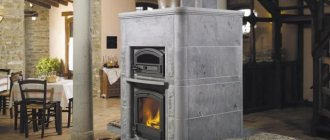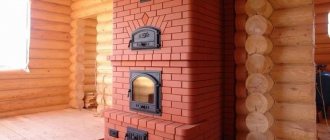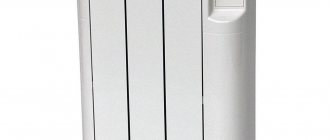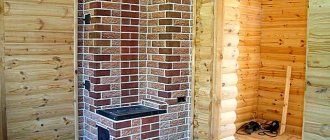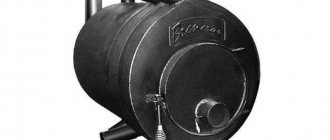Despite the variety of heating methods available for a country house, stove heating continues to be the most common. People who prefer this classic option consider it practical, not without reason. For thousands of years of human history, firewood has been the most common and, importantly, renewable natural fuel. They coped with their task perfectly - they brought warmth and comfort to the home. The place for burning wood from a primitive fire pit, after a series of transformations, turned into a structure known to everyone. Modern stoves for the home have retained their original purpose, becoming more diverse in appearance and gaining new functions.
Stove heating is a competitive option for a country house Source rinnipool.ru
When is it profitable to burn with wood?
It’s good when there is a gas main within reach of a country house. In this case, the question of choice does not arise for most owners; If wood heating is present, it is for comfort, in the form of a fireplace or a small decorative stove. If there is nothing to connect to and the house is large, the best choice would be a solid or liquid fuel boiler, since electric heating will cost much more and can only be considered as an additional (backup) option.
It’s another matter if the country house is small in area. For a building with two or three rooms and a kitchen, the number of heating methods is greater, but the most common is still the use of wood. In country cottages, wood heating is beneficial in the following cases:
- Seasonality of residence. Heating with wood is especially beneficial if people do not live in the house permanently, but use it for seasonal recreation. Even if there is a gas main nearby, it is not always cost-effective to carry gas.
Wall-mounted method of arranging a modern wood-burning stove for heating a house Source kamine-streubel.de
- Availability of fuel. If there are no problems with the procurement of firewood in the area, heating with wood will be the most economical way for a house of any size.
- Modern design. For a small house, a modern, economical wood-burning stove and well-designed heating will be the best solution.
Wise choice: what to look for
At different times in different countries there were many types of wood heating appliances. They differed in appearance, had different design features and purposes. Modern stoves for heating a home using wood can be classified in different ways:
- By appointment. Stoves can be heating, heating-cooking (then they have a hob and/or oven), special purpose (for example, for a sauna, greenhouse or garage).
- By brand. Models of both Russian and foreign production are available for sale. Among the latter are stoves from Poland, Canada, Sweden, France, Serbia, the Czech Republic and Belgium.
Hanging drop fireplace with a rotating firebox in hi-tech style Source pinterest.co.uk
- To size. Dimensions and weight can sometimes be critical.
- By location. It can be wall-mounted, corner, universal or island.
- According to the location and parameters of the chimney. Chimneys have different diameters and are located at the top, rear or top/rear.
- According to the material. The body is made of cast iron, steel, stone, brick, ceramics, tile (tile).
- According to the firebox material. The firebox is made of steel, cast iron, fireclay, vermiculite or ceramics.
- In terms of performance. The models are designed for different volumes (areas) of the heated room and have different thermal power (indicated in kW) and efficiency (from 50 to 95%).
- According to design features. There are models on the market with a fire-resistant glass or solid door, or with a water circuit (heat exchanger).
A brick heating and cooking stove conveys the atmosphere of country life. Source yandex.ru
When purchasing a wood-burning stove, pay attention to the defining parameters:
- Wall and firebox material. It is better if the stove is made of heat-resistant high-alloy steel, cast iron or black boiler steel. The walls of high-quality products are made thick (sometimes up to 8 mm) or lined with fireclay bricks.
- Economical. Long-burning designs (with a special firebox design and high efficiency) are on sale; Firewood is placed in them every 4-8 hours.
- Purpose. When choosing one design or another, you must remember that a free-standing stove will only heat the room in which it is installed; a wall-mounted stove will also heat adjacent ones (with a common wall). The sauna stove is equipped with a steam generator (a container for filling stones).
Design diagram with a long-burning water circuit Source xazovum.gezilam.ru.net
See also: Catalog of companies that specialize in insulating country houses.
Basic requirements for wood stoves
A properly selected stove must fulfill several conditions:
- Strength. The service life depends on the material and can range from 20 to 50 years (depending on the quality of workmanship and intensity of use).
- Economy. Economical fuel consumption is one of the priorities of choice.
- Compactness. An important parameter in a small house.
- Efficiency. Ideally, the stove should not only quickly warm up the house, but also maintain a comfortable temperature throughout the day.
- Safety. The stove, as a source of open flame, is subject to special fire safety requirements. The surface should not warm up above 90-95°C.
- Aesthetics. It’s great if the appearance of the stove complements and emphasizes the overall design of the house.
Fireplace stove with hob, Poland Source en.aviarydecor.com
How to protect a country house from fire when installing a stove
Fire regulations require protection of walls and floors made of combustible materials when using solid fuel heating equipment. Fire prevention measures include:
- Use of thermal insulation materials with a high degree of fire resistance to protect walls and ceilings at the installation site.
- Application of fire protection: impregnations and mastics.
Safe installation of the furnace and the use of fire prevention products are a mandatory requirement for the operation of furnace equipment.
How to cover the walls and ceiling when installing an iron stove
The part of the ceiling located above the stove and at the point where the chimney passes, as well as the adjacent walls, experience severe thermal stress. The following fire safety conditions and measures are considered mandatory: {banner_downtext}
- The ceiling is made of non-combustible materials. The use of wooden and plastic panels is not allowed. It is optimal to use gypsum fiber boards treated with gypsum putty for painting.
- The walls are protected with basalt cardboard followed by sheathing with steel sheets. For convenience, we use ready-made protective decorative wall screens made of stainless steel, which have a beautiful appearance and provide a high degree of safety. The walls are protected with plaster with a thickness of at least 3 cm, as well as brickwork.
Fire safety requirements for installing a metal stove in a wooden house are described in detail in SNiP 31-05-2003 (SP 117.13330) and SP 118.13330.
Fire retardant treatment of wooden structures
Where the stove is installed, wooden walls are protected using fire retardants: mastics and impregnations. Load-bearing structures and beams must be processed. Fire retardants are applied to the walls and floors where the furnace equipment is installed.
Mastics and impregnations have been developed for protection. The former provide better fire protection, the latter are almost colorless.
The order of installation regarding fire safety measures specified by the manufacturer is specified in the technical documentation. Fire protection work is carried out by representatives of the Ministry of Emergency Situations. You can take measures to prevent fire yourself, but before putting the stove into operation, you will need to obtain a certificate from the inspector of the Ministry of Emergency Situations about the fulfillment of all requirements of the safety regulations.
Detailed parameters for installing a solid fuel heating country stove are described in the technical documentation attached to the heaters of leading European and Russian factories. Compliance with the described rules is mandatory.
Types of wood stoves
Currently, there are many types of wood stoves, the most common of which are:
- Traditional. They are built from brick or stone, and are considered not only durable, but also safe. These include the Russian stove, the Swedish stove, and the Dutch stove. Such structures heat the room slowly, but they also retain heat much longer than metal ones. Today there are practically no craftsmen left who know how to build a high-quality warm stove, and you also need to know how to use it. Therefore, they are rarely staged, mainly by adherents of antiquity or exoticism.
- Fireplace s. A classic fireplace is an open hearth that looks great in any setting. Spending an evening near it, watching the flames, is highly romantic, but not practical. A traditional fireplace does not cope well with high-quality heating of the room, but a modern fireplace stove does this much more efficiently.
Modern stove-fireplace made of cast iron Source otopleniehouse.ru
- Metal. In modern conditions, metal wood-burning home stoves are the most common option due to their low cost and ease of maintenance. They belong to the category of rapidly heating structures; The air temperature in the room rises within half an hour, but the wood burns out quickly.
- Furnaces with a water circuit. A water circuit is built into the furnace structure - a container with water and a pipe system connected to batteries. The heated gases give off heat to the water, which carries heat throughout the house. Such stoves are convenient because they can be installed anywhere in the house (where it is more convenient to build a chimney).
- Gas generators. Such designs are called long-burning furnaces. They are distinguished by compactness, high efficiency (from 80%) and a special design. The firebox consists of two chambers; In the first chamber, wood is burned, in the second, pyrolysis gas is accumulated and burned. There are several varieties on sale, including Buleryan, Professor Butakov’s stove, and Stropuva’s stove.
Design and rules for placing the stove
Despite the variety of designs, all wood stoves produce energy to heat the air by burning wood. Therefore, they all consist of the same set of elements, which include:
- Firebox. Place where wood is burned, chamber made of heat-resistant materials.
- Grate (grid). Metal grate at the base of the firebox. Firewood is placed on it, air enters the firebox through it and ash is removed.
- Ash pan. A small chamber under the firebox where ash accumulates.
- Chimney. A pipe through which combustion gases are removed.
- Smoke damper. Blocks the chimney to retain heat.
Safe placement of an iron stove for a wood-burning home on a fireproof glass stand Source monitoruldevrancea.ro
Advantages and disadvantages
Using a wood-burning stove for home and garden (the modern version) in many cases has significant advantages:
- Easy to install and operate.
- Efficiency and economy. A high level of efficiency and careful consumption of firewood is ensured by various technological methods, from the shape of the exhaust pipe to the long-term burning mode.
- Quick effect of work. The heat from a working stove spreads quickly, a comfortable temperature is established within half an hour.
- Compactness. This quality is especially valuable in small country houses. Such a heating device can be installed in any room (if there is a chimney).
Characteristics of metal products
Metal furnaces are made of heat-resistant steel. The properties of this material contribute to the rapid heating of the room. At the same time, its thickness is small, so heat cannot be retained in the room for a long time.
To achieve a long-lasting effect, manufacturers use stainless steel. Based on this, metal products are divided into thin-walled and thick-walled furnaces. The first of them are used as permanent heating structures, the second are installed for periodic use as needed.
Stainless steel products have disadvantages. The area where the seams are placed is the weakest point. It is not recommended to heat such an oven quickly. This may cause cracks in the housing.
Metal stove coated with special paint.
The heyday of the production of wood-burning potbelly stoves for summer cottages occurred in the first half of the 20th century. They were the predecessors of modern metal products. The spread of gas stoves and central heating systems gradually replaced potbelly stoves from the list of items of general use. But country and country houses are still dependent on stoves, whose structures are entirely made of metal along with the chimney.
Video description
About the stove after two years of use in the following video:
- Multifunctionality. Modern models delight with thoughtful functionality. There are options that can switch to another fuel (coal or wood waste). Many models can be used not only for heating, but also for cooking or heating water.
- Safety. Properly installed (according to SNiP rules) stoves comply with all safety standards, regardless of design and material of manufacture. Many units have the ability to regulate the combustion or afterburning of gases.
- Appearance. A wood-burning stove can become a decoration for your home. Manufacturers offer options for interiors decorated in any style. You can purchase a model in a modern, strict and rational design, or in a national design, using spectacular details (even hand-painted tiles).
Tiles resistant to high temperatures Source versace-promo.ru
Installing a chimney in a wooden house
The combustion temperature inside the firebox of a solid fuel stove is at the level of 450-550°C. The surface of the chimney heats up to 300°C. When soot ignites, short-term heating to 800-1000°C is possible. Due to high temperatures, fire breaks must be provided when installing metal chimney pipes.
Existing PPB rules stipulate compliance with the following conditions:
- Chimney type - it is recommended to install a sandwich pipe made of stainless steel and ceramics with thermal insulation.
- Breaks and thermal insulation materials - in places where they adjoin the walls, the pipe is removed from the surface by 25 cm. The walls are covered with basalt cardboard, followed by sheathing with stainless or galvanized steel.
- Installation of ceiling cutting - when passing through the floor slabs, leave a distance of 25 cm on each side between the surface of the pipe and the combustible material. The gap is filled with basalt insulation. The use of factory ceiling trim is allowed.
The chimney is discharged inside and along the outer wall of the building. In the first case, care is taken to ensure sufficient insulation of the pipe when passing through the floors and roof. In the second, it becomes necessary to ensure that the chimney is fixed to the walls of the building to overcome the wind load.
Wood stove prices
The secret to the popularity of wood-burning stoves lies in their wide capabilities and variety of offerings. On the market you can find both budget compact options and luxurious units that can decorate the most sophisticated interior. No matter how charming a stove may be, constantly throwing firewood into the firebox is a boring task, which is why more and more owners of country cottages prefer long-burning stoves.
A modern version of a traditional way of heating a home Source savoie-mont-blanc.com
If you look at average prices (in the Moscow region), they will look like this:
- Metal stoves. Heating: 5-16 thousand rubles. (depending on design). Heating and cooking: 9-35 thousand rubles. (domestic and imported). Stove-fireplace: 20-40 thousand rubles. (may have a stove and heat exchanger).
- Cast iron: From 20 to 120 thousand rubles, depending on the size and design.
- Stoves lined with tiles (tiles): 50-80 thousand rubles.
- Stone (from granite to Brazilian sandstone): 60-200 thousand rubles.
- With a water circuit: 20-55 thousand rubles.
- Long-burning stoves: 15-45 thousand rubles.
- Potbelly stove: 9-16 thousand rubles.
Let's admire the fire
Relax and relax if your stove has a glass fireplace door. With it, it will turn into a fireplace stove. Through the glass, admire the play of violent flames and while away the time. The size of the glass and door affects the view and the price. More glass means better visibility of the fire and more pleasure. True, you will have to pay more when purchasing. There are only 2 manufacturers of fireplace glass in the world - Japanese NipponGlass and German SchottRobax. Both Russian and foreign companies supply only them. There are no Russian glasses. Glass is most often rectangular, but there are stoves with semicircular, panoramic, and prismatic glass.
